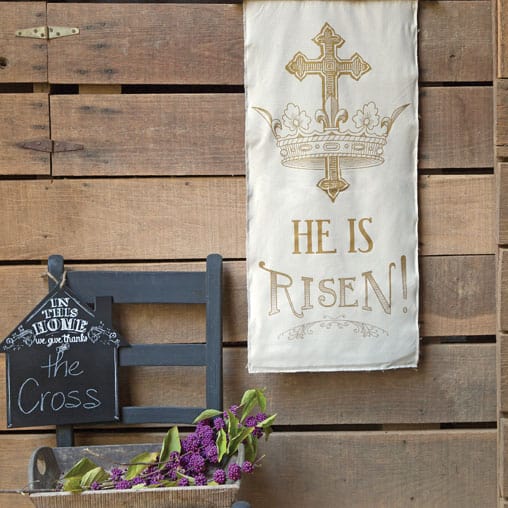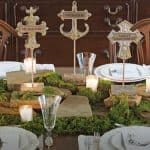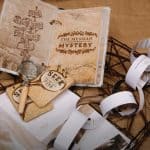
Gathering ‘Round the Easter Table
No holiday is complete without gathering around the table for a family meal. This Easter why not decorate your table with visual reminders of who Christ is and what He's done for us? Ever Thine Home® creator Barbara Rainey shares how she plans to decorate her Easter table and gives listeners some simple yet creative ideas on how they can do the same.
Show Notes
About the Host
About the Guest
-
No holiday is complete without gathering around the table for a family meal. This Easter why not decorate your table with visual reminders of who Christ is and what He's done for us? Ever Thine Home® creator Barbara Rainey shares how she plans to decorate her Easter table and gives listeners some simple yet creative ideas on how they can do the same.
-
Dave and Ann Wilson
Dave and Ann Wilson are hosts of FamilyLife Today®, FamilyLife’s nationally-syndicated radio program. Dave and Ann have been married for more than 38 years and have spent the last 33 teaching and mentoring couples and parents across the country. They have been featured speakers at FamilyLife’s Weekend to Remember® marriage getaway since 1993 and have also hosted their own marriage conferences across the country. Cofounders of Kensington Church—a national, multicampus church that hosts more than 14,000 visitors every weekend—the Wilsons are the creative force behind DVD teaching series Rock Your Marriage and The Survival Guide To Parenting, as well as authors of the recently released book Vertical Marriage (Zondervan, 2019). Dave is a graduate of the International School of Theology, where he received a Master of Divinity degree. A Ball State University Hall of Fame quarterback, Dave served the Detroit Lions as chaplain for 33 years. Ann attended the University of Kentucky. She has been active alongside Dave in ministry as a speaker, writer, small-group leader, and mentor to countless wives of professional athletes. The Wilsons live in the Detroit area. They have three grown sons, CJ, Austin, and Cody, three daughters-in-law, and a growing number of grandchildren.
-

Barbara Rainey
After graduating from the University of Arkansas with a Bachelor of Arts degree in history, Barbara joined the staff of Cru® in 1971. With her husband Dennis, whom she married in 1972, the Rainey’s cofounded FamilyLife®, a ministry committed to helping marriages and families survive and thrive in our generation. Barbara is a frequent speaker and guest on FamilyLife Today®, FamilyLife’s award-winning nationally-syndicated daily radio broadcast. She is the author or coauthor of...more
Barbara Rainey shares how she plans to decorate her Easter table and gives listeners some simple yet creative ideas on how they can do the same.
Bob: There are times in our relationships with each other when we just can’t see eye-to-eye—times when we may need to call on a mediator. Here’s Barbara Rainey.
Barbara: Kids need Mom and Dad to mediate their squabbles and their disagreements. They need someone to come in and help sort out all the tangled mess of their sibling rivalry and their bickering. Kids on the playground get into some kind of a misunderstanding and they need the teacher, or the person who is on duty on the playground, to come in and sometimes break it up.
We’re not naturally good at resolving our differences. We don’t know how to keep our relationships right—keep them clean. We need help. We all need help. We need help in our marriages. We need help in our families, and we need help with our friends and our coworkers. Because I can have a relationship with the Father—because of Jesus—that gives me all that I need to have the relationships that I want to have—
1:00
—with my husband, and my children, and my friends, and all these other horizontal relationships.
Bob: This is FamilyLife Today for Wednesday, March 18th. Our host is the President of FamilyLife®, Dennis Rainey, and I’m Bob Lepine. Our human relationships aren’t the only relationships that need a mediator. Our relationship with God, broken by our sin, also needs mediation; and Jesus is our Mediator. Stay tuned.
And welcome to FamilyLife Today. Thanks for joining us on the Wednesday edition. This is one of those days when you kind of wish it was TV and not radio because most of our guests don’t come in and decorate the studio before we do a radio program; but your wife—
Dennis: She’s not like most of our guests. [Laughter] And trust me, you know that.
2:00
Welcome to the broadcast, Sweetheart.
Barbara: Thank you.
Dennis: I knew you’d get a reaction from Bob on this, but she has—you know, here’s what our listeners ought to know—we operate off of an antique oak—is that what it was, Keith? Is it oak? You refinished it 20 years ago.
Bob: He says it is plywood.
Keith: It is plywood.
Dennis: Oh, it’s not plywood!
Barbara: It’s vintage.
Dennis: It’s vintage! We—yes—
Bob: It’s a dining room table.
Dennis: It’s a dining room table that’s been refinished—that Bob and I felt like we wanted to have guests in here and we wanted it to feel like it was—we were talking in the kitchen.
Bob: We knew that there would be a lot of folks on FamilyLife Today who weren’t used to being on the radio—folks who’d had life-change stories—we’d want to share their story—but they’d come in—if it felt like a studio, they’d get all locked-up.
Dennis: Right.
Bob: So, we said: “Let’s just put in a dining room table. We’ll put some microphones on it, and we’ll make that our studio.”
Dennis: So, Barbara saw it; and what did she do, Bob?
Bob: She put silverware, and she put plates. There is no food—I just want to point out—
3:00
Barbara: I know. I know.
Bob: —is everything here—
Barbara: I didn’t plan very well. [Laughter]
Bob: But you’ve got this decorated in part because a lot of moms do think about the Easter meal. Easter’s coming up, here in another couple of weeks, and we may not think much about Easter until we’re in the middle of the week before; but at that point, a lot of moms are thinking: “Okay, am I cooking a ham this year for Easter? What am I going to do for Easter? Do you decorate the table in some special way?”
Dennis: And then: “What kind of dresses are we going to buy the girls?” and how the boys are going to get a pair of shoes.
Bob: “New shoes for the boys,” and then, there’s the: “Are we going to do anything with bunnies and eggs?” I mean, that’s the typical drill for Easter; right? You’re suggesting that moms can, maybe, decorate their table with a little more purpose in mind than just an Easter basket for the kids or a Jell-O® mold in the shape of a bunny.
Barbara: Yes, I’m hopeful we can help elevate the celebration of Easter more in keeping with how important it really is.
4:00
The celebration of Easter should be the most momentous occasion of the year. We should jump, and dance, and sing, and clap, and rejoice because of what Christ did for us on the cross—we have been set free, we are going to heaven, our sins are forgiven—and we should make a big, big deal about that.
I think that we might know that, intuitively, in our hearts; but we don’t really know how to do it. So, we just do the easy thing—we go to the store, and we buy some eggs. We put them in a basket and throw a little green grass around it. We just kind of go, “Okay, so, we’re going to celebrate spring because I don’t really know what else to do.”
So, I’m hopeful that we can help families—help women, in particular—know how to set an Easter table that’s focused on the cross—that’s focused on Christ—where you can have some meaningful conversation, and you can have an event at your home with your family that marks Easter in an important way.
5:00
Bob: So, is what we have here on our studio dining room table what your table will look like this year for Easter?
Barbara: Partly, because this is a little smaller. Yes, mine will be a little bit more elaborate.
Bob: So, you want to explain what this looks like so our listeners can get some idea of what your table is going to look like?
Barbara: I brought in white plates for all of us because one of the elements about Easter that is so important is that, when Christ sacrificed His life for us, He gave us clean hearts. White has always been a symbol of purity, and it talks about in Revelation—how we will be clothed with white linen.
Probably, at my house, I will have either a white linen table cloth; or I will have a white table runner, or napkins, or something to symbolize that white that we will be wearing one day when we are in heaven. For the studio here, I’ve just got white plates; and I’ve got silverware. On each plate, are cards that talk about what some of the miracles are from the first Easter.
6:00
But more importantly, for right now, I want to turn your attention to what’s in the center of the table because I think all of us, as women, want to create a centerpiece/a focal point on our table that’s something kind of special and out of the ordinary. What I have on this table—that I will have on my table in a few days when I get all fixed up for Easter—are three crosses.
The three crosses are from the Adorenaments® collection that we created at Christmas last year as Christmas ornaments, but these three crosses come on stands. They can be put up and left up year-round. You could put them in your kitchen on a counter / you can put them on your fireplace mantle; but for Easter, I’m going to put mine on my dining room table and make that be the focal point of our Easter brunch on Easter Sunday.
Bob: And the three crosses all have names on them.
Barbara: Right.
Bob: The anchor cross says, “Messiah,” and then, there is another cross—and is that the descending dove at the top of that cross?
Barbara: Yes, that’s the Armenian cross—
7:00
—and it has a dove on the top of it.
Bob: And it says, “Mediator.” The descending dove, of course, is the symbol of the Holy Spirit coming down. Then, there is a third cross that says, “Great High Priest.” What’s the origin of that cross?
Barbara: The Ethiopian cross is a very important symbol in the country of Ethiopia.
I think a lot of it goes back to the story in Acts when Philip encountered the Ethiopian eunuch on the chariot. He got down and explained to him what the Isaiah scroll meant that he was reading and he received Christ. He believed on Christ for salvation, and he went back to his country. More than likely, the Ethiopian eunuch evangelized much of his country because this cross has been a symbol of the country of Ethiopia for centuries and centuries—long, long time.
So, I love having that as a part of this collection of crosses because it’s a cross from the continent of Africa. They don’t all come from different continents, but quite a few of them do. I think it is fun because it’s a visual representation of the gospel going to all the corners of the earth.
8:00
Dennis: And the concept of “Great High Priest”—you know, Bob, a lot of folks, who are Protestants, don’t really have, I think, a working definition of a priest.
Bob: Well, we have pastors / we have preachers. I mean, we refer to the folks who lead our church as elders, or reverend, or whatever else; but we’ve shied away from calling any man a priest because of the Bible’s declaration that we have one mediator between God and man—one priest in Jesus. Jesus is, indeed, the Great High Priest.
Dennis: Right. And Hebrews talk about this—of how He shed His blood for us and became our Great High Priest. I think this is one of the most important names that we need to be teaching our children because it lifts God up—it lifts Christ up to His noble, rightful place as one who did something for us that no other God-man could possibly do.
9:00
Barbara: I think a part of what’s interesting about this name too—that Jesus is called our Great High Priest—is that He was our priest. He is the One who went before the Father for us; but He didn’t just go before the Father / He didn’t just go into the inner place on our behalf—He went in as priest and, then, He became the sacrifice.
In the Old Testament—in the Temple, the high priest—not the Great High Priest—just the high priest would go in and make an offering on behalf of the people to reconcile them. It was called atonement; but Jesus went in, as our Great High Priest, and then became the sacrifice. So, He did both for us. He fulfilled that role of being the priest that we needed to bring us to God, but He did it by becoming a sacrifice.
Bob: And what made Him the Great High Priest, once and for all,—
Barbara: That’s right.
Bob: —is that He doesn’t have to go back and repeat the sacrifice. I mean, Jews—year-in/year-out—
10:00
Barbara: Year-out.
Bob: —there was the perpetual state of sacrifice. It wasn’t just once a year on the Day of Atonement that they would do sacrifice. There were lambs being offered every day.
Barbara: Right.
Bob: Day of Atonement was a huge festival around that whole idea of atoning. When Jesus made the sacrifice, as our Great High Priest, sacrifices were done.
Barbara: Were over.
Bob: We don’t need to make another one.
Barbara: You mentioned one of my favorite phrases in the Bible, and that is “once for all.” And in Hebrews, it’s repeated several times—but just to think about how important that is because, as you were saying, the priest had to do this over, and over, and over, and over. There is something that happens when you repeat something—it becomes so old; and yet, Jesus went in and one time—He only had to do it one time. He was the perfect sacrifice. It was done, and it was over.
It is such a marked contrast with what the priests had to do because they just kept repeating this—
11:00
—and nothing changed, and nothing changed, and nothing changed. Then, Jesus came as priest—and boom!—He did it once, and it was over. So, I just love the phrase, “once for all,” because it is such a picture of everything that He did in those three words.
Bob: Well, on the Day of Atonement—for a Jew, if you would take your offering / your sacrifice—the lamb was slaughtered / your sins transferred to lamb. The lamb is then slaughtered. As soon as you walk away—whether it’s a sinful thought or a sinful attitude—
Barbara: Exactly.
Bob: —or a sinful word—
Dennis: You were in need of another sacrifice.
Barbara: Yes.
Bob: And it’s next year before we do this again—
Barbara: Yes.
Bob: —but Jesus sacrificed once for all—the sins we have committed, the sins we are committing, the sins we will commit have all been forgiven in Him.
Barbara: It’s all covered. It’s just so remarkable, and that’s why Easter needs to be celebrated with a lot more—I don’t even know what the words are. We just need to elevate Easter because what He did for us is so incredible.
12:00
Yet, our celebration is so minimal, by comparison, that we need to find a way to exalt what He has done for us.
Dennis: Back to the “once for all” theme that you talked about—Bob, one of the things Barbara and I are enjoying in this season of life, with our children grown, is we start our days together. Barbara’s been doing a lot of study because of creating these Adorenaments for Easter. One of the things she’s done is all this research around what took place when the priests brought those lambs there. We’re not talking about a handful of lambs.
Bob: No.
Dennis: We’re talking about thousands.
Bob: Blood running in the streets.
Dennis: This sounds barbaric to us, as Westerners; but this was a symbol to the nation of Israel of their need for a covering—a blood covering—for their sin. It makes an even greater celebration that no longer / no longer would there need to be lambs, slaughtered on behalf of human beings.
13:00
The Lamb of God was slaughtered.
These are important history lessons that teach our children—not just about what took place in the past—but to point them, forward, to help them understand that, when He did come and He was the Great High Priest—what’s taking place there and what’s wrapped up in that name.
Bob: So, we have a cross on a table that says He’s the Messiah. We’ve got the Ethiopian cross that declares Him as the Great High Priest. Then, you talked about the Armenian cross—I should say the Armenian cross because it’s not the theological Arminian. It’s the people from the country of Armenia. It’s the Armenian cross that has a descending dove and the name, “Mediator,” on that cross. A mediator is a go- between; right?
Barbara: Yes.
Bob: So, what is that designed to tell us?
Barbara: Well, this is one of my favorite crosses. I don’t know why, but it’s one of my very favorite ones. I think part of it is because it has the symbol of the dove.
14:00
It was the only one that I saw when I was doing the research that has the dove at the top, representing the Holy Spirit. I also love what’s wrapped up in the name, Mediator, because it is such a practical term for all of us in every relationship.
We’re so used to the concept of mediator that we don’t even really think about it, but kids need Mom and Dad to mediate their squabbles and their disagreements. They need someone to come in and help sort out all the tangled mess of their sibling rivalry and their bickering. Kids on the playground get into some kind of a misunderstanding. They need the teacher, or the person who is on duty on the playground, to come in and sometimes break it up.
We’re not naturally good at resolving our differences. We don’t know how to keep our relationships right—keep them clean. We need help. We all need help. We need help in our marriages. We need help in our families, and we need help with our friends and our coworkers.
15:00
This cross talks about Jesus as being that One—being that one person who mediates for us so that—because He has gone, on our behalf, to the Father, He is our Mediator. He is the One who has gone between us. And because I can have a relationship with the Father because of Jesus, that gives me all that I need to have the relationships that I want to have with my husband, and my children, and my friends, and all these other horizontal relationships. The cross, with “Mediator,” is all about what He did for us in the vertical relationship with God, the Father, so that we can, then, have those healthy relationships on the horizontal in our lives.
Bob: When we think about a mediator, in terms of a legal proceeding—somebody who takes two parties that can’t agree and tries to find a common ground. Well, in the case of Jesus being our mediator, the two parties that can’t agree are God and us.
16:00
The reason we can’t agree is because God has said, “Be holy,” and we’ve said, “We’re not,”—we’ve been sinful.
Dennis: Right.
Bob: And Jesus doesn’t come in and say, “Well, let’s see if we can find a common ground between”—
Barbara: Yes.
Bob: —“the two of you.” He comes in and says: “It’s pretty clear who is in the right here and who is in the wrong. God’s in the right. These people are in the wrong.” So, is there a way to get them together? And the way to get them together—the way to get them on the same page is for Jesus to be the One who intercedes on behalf of the people to the Father and says, “There needs to be forgiveness for these people, and I’ve done what’s necessary.” This is where Hebrews talks about Him as the One who is forever interceding on our behalf—
Barbara: Right.
Bob: —making petition before the Father and saying, “Father, forgive them because of what I’ve done.”
Barbara: God didn’t have to diminish His holiness in order to reach down to us. God didn’t have to become less. Jesus didn’t have to become less because they want us—the Father, and the Son, and the Spirit—
17:00
—want us to become holy. And so, what Jesus did was not, as you were saying, find a middle ground where God has to give and we have to give; but He came and sacrificed Himself so that we could come to God and become holy like He is holy.
And that’s just a stunning concept because we are so broken, and we are so weak, and we have so many flaws—but that that was even possible is pretty remarkable, in and of itself.
Bob: So, if your Easter table is going to have a white table cloth, or a white table runner, or white plates on it, and these three crosses in the middle, do you imagine that, during Easter dinner, you’re going to talk about the Messiah, the Mediator, and the Great High Priest? Are you going to have that conversation?
Barbara: Well, maybe/maybe not. If I had all of this and still had my kids at home, I would be talking to my kids about that before Easter. Now, if it didn’t happen, we might do it on Easter Sunday lunch. We might read the card that comes with each of those and talk about what He did for us.
18:00
But it’s a way to make a statement of: “This is what Easter is about. This is what’s important.” If it leads to having a conversation about those three names, that’s that much better; but, at least, it focuses your Easter dinner / your Easter meal on the purpose for Easter—which is the cross—rather than on something else like chicks, or bunnies, or eggs.
Bob: You’ve seen the TV interviewers, who go around and ask people, “Who is the Secretary of State?” or “Who is the—
Barbara: Yes.
Bob: —“Vice President?” and people don’t—
Barbara: —have a clue.
Bob: —can’t name—
Barbara: Right.
Bob: —who this is. You go to a lot of people today and say, “What’s Easter all about?”—they have—
Barbara: They don’t know.
Bob: —zero idea.
Barbara: Yes.
Bob: Even some people, who are going to church, don’t know what Easter is all about; do they?
Barbara: Yes, they don’t. Don’t know who Judas was, don’t know who Pontus Pilate was, don’t—just don’t know any of the basic facts.
Dennis: Well, let me just quote a passage, here, that will tell you what Easter is all about. It is in 1 Timothy, Chapter 2, verse 5: “For there is one God and there is one Mediator between God and men, the man, Christ Jesus who gave Himself as a ransom for all.”
19:00
That’s what Easter is all about. It’s about what we couldn’t do. We could not make ourselves acceptable in God’s sight.
We may be talking to somebody, right now on the radio, who’s tuned in—and you maybe even know what Easter was about—but you don’t know the God-man who was your ransom / who is your Mediator. Maybe, you are in need of moving from doubt to belief.
Well, you know what? You are in good company. The disciples had to move from doubt to belief. Even when He was raised from the dead, they saw the empty tomb, and they hadn’t believed yet; but finally, they processed everything that had taken place/all of His words, and they moved to belief—they embraced Jesus Christ for who He claimed to be.
If you don’t know Him, today is the day.
20:00
Get ready for Easter in the very finest way you can get ready by accepting God’s provision for your sin—what you couldn’t do, He did. He is your Messiah, your Great High Priest, and He is your Mediator. What will you do with Him?
And here is thing—you can receive Him right now. Just stop, right now, and say: “Thank You, God, for dying for me. Thank You for Your sinless Son, who became a sacrifice on behalf of all of my sins so that You might get me into a right relationship with You. I want to receive Him. I want Him to come in and clean me up and really give me right standing before You, as Almighty God, but then begin a relationship with You and the adventure of a lifetime.” If you’ve never done that, do it! Don’t go to this Easter season—don’t go another day without receiving the One who came to give you hope.
21:00
I’ll tell you, Bob, the more I look at this culture today, I feel like a lot of people are hopeless. They really need to know the One who can meet them where they are—forgive them, and begin to use them for His purposes, and give them a relationship with Almighty God.
Bob: You know, we have got a link on our website—at FamilyLifeToday.com—that says, “Two Ways to Live.” It really spells out what you’ve been talking about here—the choice that is in front of each one of us: “Are we going to live our lives for self, or is there a higher calling / a higher purpose in our lives? Is there something more?”
If you go to FamilyLifeToday.com, and you click in the upper left-hand corner, where it says, “GO DEEPER,” you will see a link to the “Two Ways to Live” article that really spells out what it means to have a relationship with God through Jesus Christ and for that to be the centerpiece of your life.
22:00
Our website, again, is FamilyLifeToday.com. Click the link in the upper left-hand corner that says, “GO DEEPER,” and look for the article that says, “Two Ways to Live.”
When you go there—look, as well, for the link to the Ever Thine Home® collection of resources that Barbara Rainey has designed for us, here at FamilyLife. It includes the crosses we’ve talked about today / other resources—the banner you can hang on your front door at Easter time—a whole number of resources that are all designed to get us thinking about Easter differently and to engage, as a family, around this most important day on our calendar every year.
Again, our website—FamilyLifeToday.com—click the link that says, “GO DEEPER.” You’ll see the “Two Ways to Live” article and the link for Ever Thine Home collection of resources. Of course, you can order those resources from us, online, if you’d like; or you can call if you have any questions or would like to place an order. 1-800-FL-TODAY is the number to call—
23:00
—1-800-358-6329. That’s 1-800- “F” as in family, “L” as in life, and then, the word, “TODAY.”
Let me, quickly, just say a word of thanks to those of you who make the ministry of FamilyLife Today possible. We’re listener-supported. The cost for producing and syndicating this daily radio program is a cost that is covered by those of you—who listen, and who get in touch with us, and make contributions to make all of this possible. And we’re grateful for your financial support.
In fact, during the Easter season, we’d like to send you a set of Resurrection Eggs®. It’s our gift to you when you make a donation today to support the ministry. Go to FamilyLifeToday.com and click the link in the upper right-hand corner of the screen that says, “I CARE,” to make an online donation. Or you can call 1-800-FL-TODAY—1-800-358-6329. Be sure to request a set of Resurrection Eggs when you do that.
24:00
Or you can mail your donation to FamilyLife Today at PO Box 7111, Little Rock, AR. The zip code is 72223. And again, be sure to ask for a set of Resurrection Eggs when you get in touch with us.
Now, tomorrow, we have some ideas on things you can talk about during Easter dinner. We’ll share some suggestions with you if you can tune in tomorrow. Hope you can be here.
I want to thank our engineer today, Keith Lynch, along with our entire broadcast production team. On behalf of our host, Dennis Rainey, I’m Bob Lepine. We will see you back tomorrow for another edition of FamilyLife Today.
FamilyLife Today is a production of FamilyLife of Little Rock, Arkansas.
Help for today. Hope for tomorrow.
We are so happy to provide these transcripts to you. However, there is a cost to produce them for our website. If you’ve benefited from the broadcast transcripts, would you consider donating today to help defray the costs?
Copyright © 2015 FamilyLife. All rights reserved.
1




